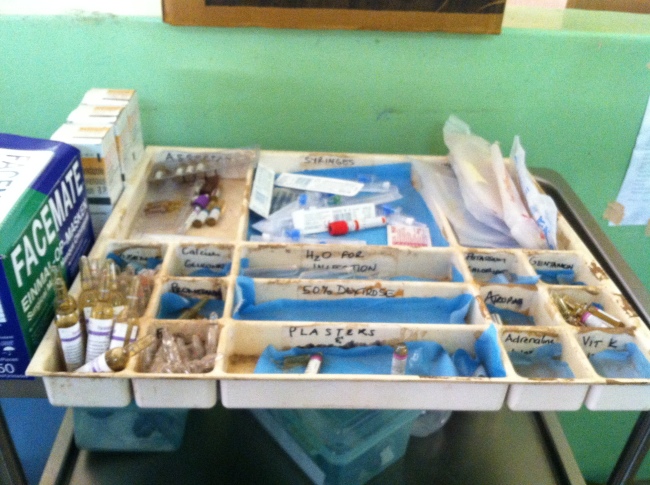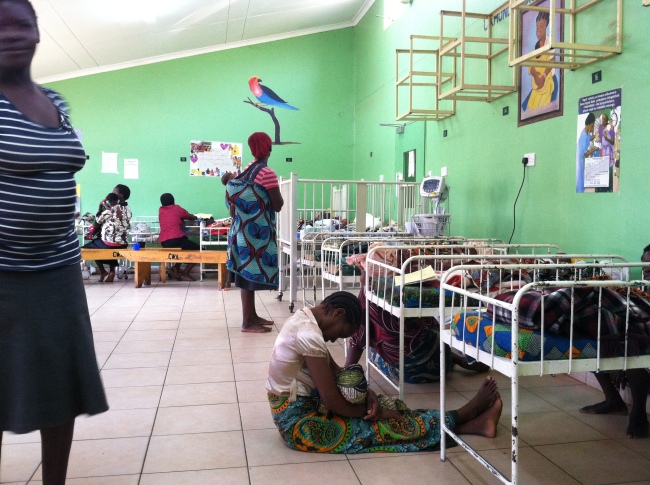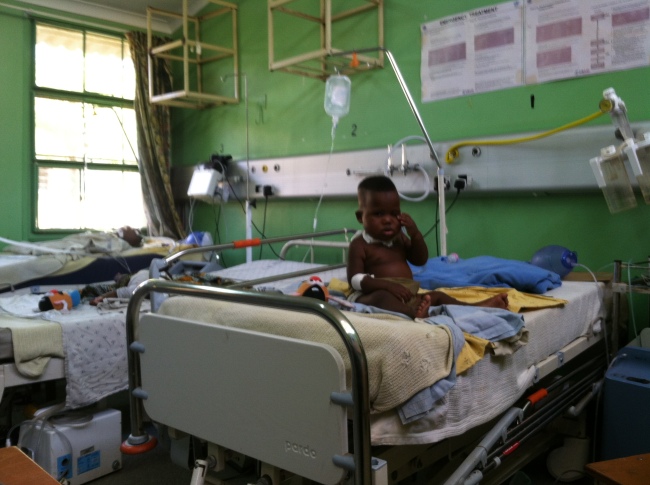The Malawi Nursing and Midwife Council requires a mandatory “orientation” for all expatriate nurses wishing to function in a clinical role while in Malawi. This process can be from 4-6 weeks, at the Council’s discretion. The Council recommended my orientation to be 4 weeks.
Kamuzu Central Hospital (KCH) is the tertiary referral center for the central region of Malawi, a catchment area of about 5 million people. Rough estimates of the hospital’s size expand a range from 600 to 1000 beds (the actual occupancy almost always exceeds the intended or optimal occupancy). The hospital is centrally located in Malawi’s capital “city” of Lilongwe and has five floors, four operating theatres (potentially), an adult emergency department, one adult and one pediatric ICU, three large pediatric wards (including pediatric emergency), a maternal center, a neonatal nursery, a laboratory (unsure if there is a fulltime pathologist and often results are delayed) and a radiology department (ability for plain films and ultrasound and I think the CT scanner is working now but no MRI that I know of and on a good day you might even find a trained radiologist).
My placement was spent in pediatrics (including neonatal). I alternated my time between the two pediatric wards, the nursery, and spent the majority of clinical in pediatric ward “A” which included the nutrition rehabilitation unit, the high dependency unit (or ICU), the U5 clinic (urgent care/triage), and the “emergency” area of pediatrics (where I naturally gravitated). These past 4 weeks proved to be eye opening as I was able to experience first hand how healthcare is managed in Malawi. I would find that many of the things I would want to do clinically to care for patients – well…just were not always an option. At current staff, there are only 4 pediatricians available (2 Malawians and 2 Expatriates – 1 is a fellow GHSP Volunteer, Dr. Margot Anderson, who works her New Orleans tail feathers off at KCH) to manage the sometimes 300+ pediatric patients, some whom are extremely sick. Nursing is stretched as well. Nurse: patient ratios can range from 1:10-30 to 1:60-80 depending on staffing availability for any given day or night (the one exception is the ICU nurse: patient ratio of 1:3 or 1:6 – which easily doubles with bed sharing).
In week one, I had my first experience with death, a burden I would learn in the coming days, weeks and months to be almost too unreasonable to bear for any human, but such is life in Africa. I had just arrived to the emergency section of Pediatric Ward “A” and noticed staff gathering to the bedside of a 6 month old in acute respiratory distress. After multiple attempts, including EJ (external jugular – which is done here without sterile procedure – and they are quite skilled in it), we couldn’t obtain patent IV access…and no IO was available (inter-osseous – which proves to be a lifesaving and quick procedure during a resuscitation – the hospital was waiting for more supply). There were no working monitors to trend vital signs. We were able to provide oxygen via nasal cannula CPAP (continuous positive airway pressure, a treatment that uses mild air pressure to keep the airways open)…but ultimately the patient coded (as evidenced by posturing, limp and breathless without palpable pulses or audible heart tones)… none of the present nursing staff were reacting to the deteriorating clinical situation (or at least not how I would have anticipated)…so I stepped in along side the pediatrician to palpate for a femoral pulse and auscultate for heart tones while looking at the pediatrician and saying “she has no pulse…. I am going to start CPR…ok?”.
Working in the pediatric emergency department in Colorado, this delayed response by the nursing staff to initiate CPR would have been viewed as a gross hesitation (a lack of good clinical judgment) and asking for permission to begin CPR, unheard of – but here in Malawi I am learning to wage my actions differently. I am finding my way in Malawian healthcare. I have learned it would have been more inappropriate for me to initiate CPR on my own. I am learning that sometimes doing nothing…is better than doing something (a concept that remains a challenge for me).
However, given the circumstances at hand, standing at the bedside and waiting for action was not an acceptable resolution in my Western trained emergency mind (at that time)…. so I negotiated my actions by first asking for permission before initiating CPR. I had to navigate what my emergency nursing training was telling me to do…while being culturally sensitive to the environment I was working within. Without IV/IO/ET access to give critical medicines like epinephrine, etc….no EKG or other monitoring devises…no AED or usable defibrillator…. and no appropriate blade sizes to intubate…I felt compelled to react, as trained. Another nurse searched for an ambu bag (a self-inflating bag to assist in breathing)…eventually an appropriate sized mask was located… and at the direction of the pediatrician, she and I continued 2 person CPR…in a room with about 70 other sick patients and their caregivers watching us, including another infant sharing the same bed as the patient we were trying to resuscitate back to life. The moments here can sometimes feel surreal.
Here in Malawi, I (…or we) will be trying to function clinically within an already severely overworked, understaffed and otherwise seemingly broken system…handicapped within a resource limited setting. There can be scarcity with drug supply, critical antibiotics and analgesics needed for treatments, procedures and comfort. There are no mosquito nets covering the beds to protect patients from the impending malaria diagnosis. The lack of appropriate supplies for personal protective equipment wage risk for exposure to TB and blood borne pathogens. Management of immunocompromised patients becomes that much more difficult. Supplies for simple procedures like laceration repairs, lumbar punctures, intravenous access and rehydration fluids may be limiting in the options you can choose. What would otherwise be simple management of dehydration becomes life or death.
Orthopedic patients may sit for weeks in traction to reset bones (procedures that would be corrected within hours in pediatric emergency departments in the US). Babies born and who soon will die from “birth asphyxias” and other conditions requiring surgical interventions that are just simply not possible here. Wound care, burn care, infection control…often trying to find a sink with soap and running water is a challenge – need I say more.
Oxygen. Without it, life is lost. Oxygen is taken for granted in the US healthcare system as always being readily available for any patient at any time. For healthcare in Malawi, this isn’t the case. Access to oxygen is in short supply for the number of patients who could actually benefit immensely from it’s use…and triaging to decide which patients emergently versus urgently need oxygen over others is mind boggling. To add to the complexity of limited resources, there are limited working ventilators (a machine that supports breathing) here for patients…so mothers, grandmothers, fathers, siblings, family members are the one’s burdened with bagging their intubated child all day and through the night securing their best chances for survival. A picture truly is worth a thousand words.
And while the mortality rates for children under age five in Malawi remain unacceptably high (about 1 child out of every 8 dies), it is remarkable, given the circumstances, that some children do, in fact, survive. Some children do, in fact, grow and develop into adults. Resiliency – doesn’t seem like a strong enough word to use to describe life here… or maybe rather…Africa is its best version of a definition.




